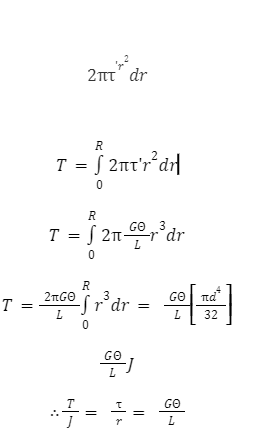Torsion is defined as the twisting of an item caused by a torque applied to it in the realm of solid mechanics. Torsion can be measured in pascals (Pa), Newtons per square metre (N/m), or pounds per square inch (Psi) (psi). Torque, on the other hand, is measured in Newton-metres (Nm) or foot-pound-force (ft.lbf). Some sections of the object are perpendicular to the torque axis, and the resulting shear stress is perpendicular to the radius in these sections. Warping is a distortion that occurs when twisting occurs in non-circular cross-sections. Transverse parts are harsh when warping.
Derivation of Torsion Equation
The torsion equation, also known as the torsion constant, is a geometrical feature of a bar’s cross-section that is involved in the bar’s axis and has a relationship between the angle of twist and applied torque, with the SI unit of m4. Following is the torsion equation:
Derivation of Pure Torsion Equation
The following assumptions were made in order to get the torsion equation:
The material is uniform (elastic property throughout)
Hooke’s law should be followed throughout the content.
Shear stress should be proportional to shear strain in the material.
The cross-sectional area of the cross-sectional region should be plane.
It is necessary for the circular segment to be circular.
The material’s diameters should all rotate at the same angle.
The material’s stress should not exceed its elastic limit.
Consider a solid circular shaft with radius R that is torqued at one end and under the same torque at the other.
Angle in radius=arc/Radius
Arc AB=RΘ=Ly
γ=RΘ/L
Where,
Two fixed positions on the circular shaft (A and B).
y : AB’s subtended angle.
(Flexibility modulus)
Shear stress is a term that has been used to describe a condition in which there is a lot
Shear strain is a term used to describe the force exerted by the shear.
Consider a small radius strip with a thickness of dr that is under shear stress.
T’*2πrdr
Where,
r: radius of small strip
dr: thickness of the strip
γ: shear stress
(torque in the shaft’s middle)

The steps for calculating the Doppler effect are listed above.
Conclusion
Torsion can be defined in basic words as the amount of twist we provide to a given object at one end when the other end of the object is fixed and does not move with the twist applied at the other end. In more precise and technical terms, the twist is the torque imparted to one end of the object. Torsion is the twisting of an object caused by a torque applied to one of its ends; it can be applied to and felt by any object. When one of a steel bar’s two ends is fixed and torque is applied to the other end, the steel bar will twist/torsion in the direction perpendicular to the plane in which the torque is applied. A rope that is fixed at one end and twisted at the other will also become twisted and have Torsion. When we twist our clothes to drain the water after washing them, we experience a twist in our clothes, which is Torsion, and the twist we apply on one end of the clothes is the torque.
However, there is a limit to the amount of Torsion that an item can endure. The elastic limit and brittleness of an object determine the degree to which it can be bent. An object’s elastic limit refers to its ability to withstand stress and alter shape. The higher the elastic level, the more tolerant the item is of form change. Brittleness, on the other side, refers to an object’s fragility and inability to withstand any form change. An object’s elastic limit and brittleness are inversely proportional. The object with a greater elastic level and therefore low brittleness may withstand more Torsion than the object with a lower elastic level and therefore higher brittleness.
 Profile
Profile Settings
Settings Refer your friends
Refer your friends Sign out
Sign out









